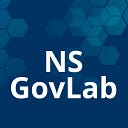By John Smith, NS GovLab fellow
At this point, we have been interviewing, testing and receiving feedback from our end users for a month. Our team is spread throughout the province and we often do our testing separately. When we came together and analyzed our data, we had some common observations:
1. Where are the men?: Our team is comprised of 4 women and 2 men. Although there are commonalities, I am not sure if men’s approach to aging and concerns are adequately represented. It may be that women are more comfortable and willing to be interviewed and share compared to men. With tongue in cheek, someone suggested we should go to Tim Horton’s. We have been to public gatherings and women are the ones that show up more so than men.
2. The 85+ demographic is underrepresented in our research and testing: This group of seniors have different needs than the 55–65 group and the 65–75 group. They are much more aware of their own mortality and end-of-life issues. Often they are becoming frailer, and physically and mentally compromised. In my last blog post I mentioned that the younger group of seniors are often living in the moment, enjoying travel, and are financially secure. I would like to see more input from the older cohort of seniors to get insights into what they are looking for.
3. The effect of financial security on needs: Some groups of seniors are reasonably financially secure with private pensions, while there are many other seniors living month to month on OAS, guaranteed income supplement and perhaps CPP. We need to make sure we are getting feedback from each group.
Though there are issues involving aging that we need to address, we know that these groups are all searching for information as they age. They are all aware the information is around, but unsure of where and how to get access to it. Many are unaware of the 211 service.
Seniors sometimes call a help line and are presented with an automated message that directs them to press a wide range of numbers and leave name, phone number and a message. These messages sometimes are not responded to for days at a time. I believe in most situations, one would prefer to speak to a real person on the other end of the phone and receive the information in a timely manner, rather than leave a message.
As an example, I tested calling an intake and information line in search of general information. I called and left my name, phone number and message and sat by the phone all day in hopes of receiving a call back on that same day. I didn’t receive a call back that day but came home the next day after errands to a missed message. Once again, I called back and was directed to leave another message. This was now the second day and ended up waiting another 4 days before connecting with a real person. We played telephone tag! When we did connect the information was what I wanted.
When people call a help line they usually have an immediate need, and the delay in talking to someone is very frustrating and one often gives up in despair. Overall, finding a way to support communities in providing information to seniors is something our team is addressing through NS GovLab and hopefully we can find something innovative to achieve this outcome.
Keep up-to-date on Medium and on Twitter (@NSGovLab).
John is heavily-involved in the aging community and believes NS GovLab a great experience for anyone looking to make a change for the aging community in Nova Scotia. He is personally challenging his traditional approach to thinking and working towards being a socially innovative thinker.
